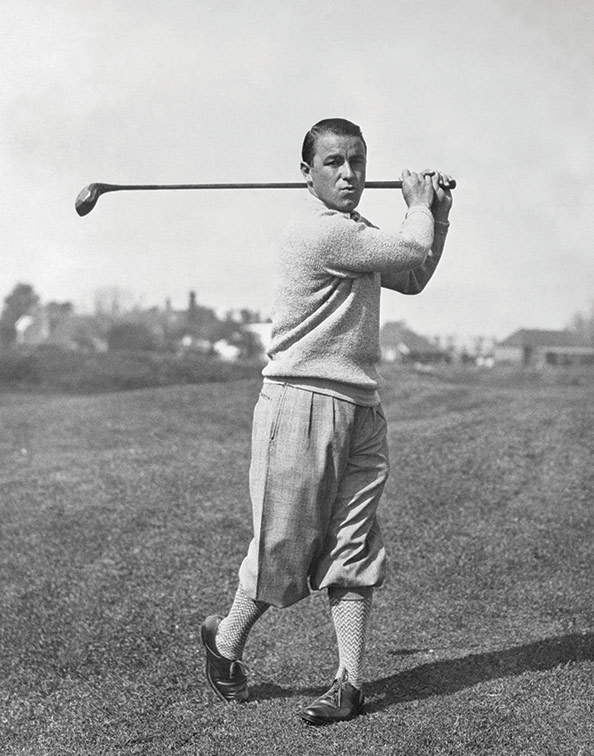(Above) Billy Bolger
Australia in 1934 was quite a different place with a population of 6.67 million. The country had just started a slow recovery from the Great Depression. That year Joseph Lyons was returned as Prime Minister. Graham Kennedy and Barry Humphries were born two days apart. Peter Pan won the Melbourne Cup. Richmond and Western Suburbs were football premiers. And it was around this time the first ute was produced by Ford in Geelong.
A rather significant achievement also occurred in Australian golf. Billy Bolger won the 1934 Australian Open at Royal Sydney with a world-record score of 283. It was the lowest aggregate in a four-round national open.
Wielding a persimmon wooden driver with a steel shaft, Bolger finished three strokes ahead of the great American Gene Sarazen who had been invited to Australia on an exhibition tour with Helen Hicks by one of the local equipment manufacturers.

Don Spence finished five behind Bolger in third place despite making two double bogeys on Royal Sydney’s short par-3 sixth. Legendary trick-shot artist Joe Kirkwood was fourth (eight strokes back) while the young amateur Jim Ferrier was seventh (15 shots off the pace).
To defeat Sarazen at his peak was significant for Bolger and Australian golf. He was certainly one of the world’s finest players at that time, probably regarded as the best having won the US PGA Championship three times, US Open twice and the British Open.
Born in 1910, William Joseph Bolger grew up at Concord in Sydney’s inner west as part of a large family. His father died when he was 12 years of age. Young Billy augmented his mother’s income by caddieing at Concord Golf Club where he started playing the game with his brothers Edward (Ted) and Fred.
Bolger’s proficiency with a golf club led to his appointment as the first professional at what was to become Ashlar Golf Club in 1929. Two years later he transferred to the newly formed Oatlands Golf Club. At the official opening there in 1931, Bolger entertained those in attendance by driving a golf ball from a plasticine tee placed on the forehead of his assistant.
PGA professional Tommy Moore recalls seeing Bolger at an exhibition in 1948 at Asquith Golf Club. Every time one of the pros achieved a birdie, the gallery would throw coins onto the green.
“He was a very unassuming sort of fellow,” says Moore who established the golf heritage movement in Australia. “He was a lovely bloke. As I remember him, he had a slight impediment in his speech, so he didn’t go in for talking a lot.
“Billy was a wonderful golfer, a very wristy player . . . and absolutely magic around the green with his pitching. He could sort of pick the ball off bare lies and all that sort of thing.”
Bolger didn’t hit a long ball through the air. But he used to generate substantial length from a driver with eight degrees of loft on unwatered fairways that enabled quite a bit of run.
“They tell me he would arrive at the course just in time to put his shoes on. And he often didn’t do the laces up. He would throw a ball on the ground and hit it with a 1-wood [off the deck]. That’s how good he was.”

Bolger’s Place In History
After leaving Oatlands, Bolger earned a living as a teaching pro for the sporting retailer Mick Simmons. For many years pre-WWII, he used to give lessons in the nets at its Haymarket store near Central railway station.
We’ll never really appreciate how good Bolger actually was as a golfer. Back in the 1930s, there weren’t the financial incentives for Australian professionals to travel abroad – which took four weeks by boat to England.
Bolger passed away on 27 August 1977. So it’s a little bit lost in history that one of the wonderful players in Australian golf didn’t really have the chance to prove himself on the world stage.
“These blokes were the best of their era. If he was alive today he would be part of this era and he would be top of the tree,” Moore says.
It’s worth noting six months after finishing runner-up to Bolger at the 1934 Australian Open, Sarazen would win the ‘Augusta National Invitation Tournament’ in a playoff against Craig Wood. In the final round Sarazen holed a 4-wood from 235 yards for an albatross 2 on the par-5 15th – described as “the shot heard ‘round the world”. That Masters’ victory cemented Sarazen’s place in history as the first golfer to win all four of the current Major championships.
‘The Squire’, as he was known, made good on his promise to avenge his defeat to Bolger and returned to Australia and won the 1936 Open at Metropolitan Golf Club in Melbourne to become the tournament’s first international champion.




